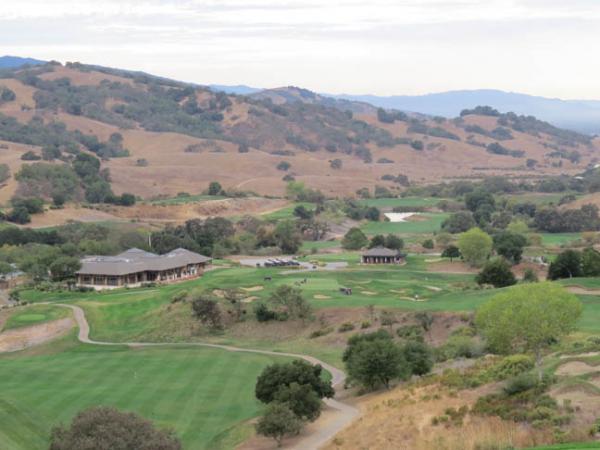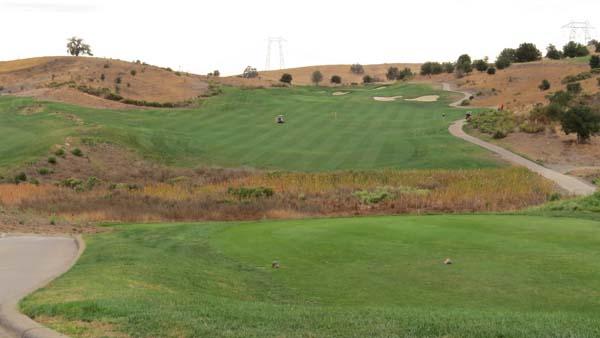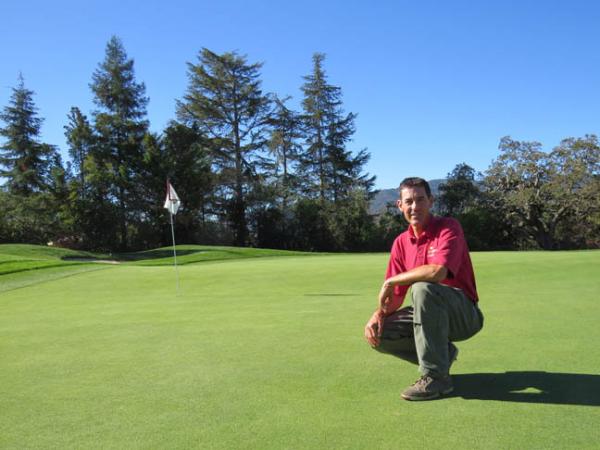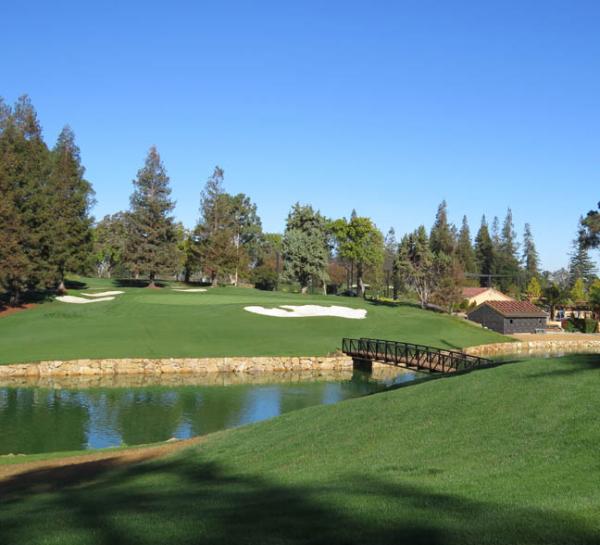
Ask just about anyone who knows Brian Boyer and they'll tell you he's pretty innovative, even for a golf course superintendent. But there are some things even Boyer can't do, like pull a rabbit out a hat or draw water from the arid hillsides around San Jose, California. After four years of drought in California, coaxing water from the ground and rodents from a chapeau happen are pretty much the same thing.
So when the Santa Clara Valley Water District informed Boyer early in 2014 that he had a month to take Cinnabar Hills Golf Club off of surface water in favor of an alternative source, there was just one teensy, weensy problem.
"We don't have an alternative source," Boyer said.
"Folks who didn't have an alternative, they let them stay on."
Recycled water will not be available at Cinnabar Hills at least for another three to five years, according to the SCVWD's five-year plan. Potable isn't an option either. The homes surrounding Cinnabar Hills on the southern reaches of San Jose all are on wells, but attempts to find well water underneath the golf course have come up dry literally. In fact, if not for surface water Boyer treats on site, even the clubhouse restaurant well let's just say there would be no clubhouse restaurant, or bathroom or you get the idea.
"We dug everywhere for wells," Boyer said. "We don't have any."
Oh, by the way, Boyer also was told by SCVWD to cut water use by 20 percent through the remainder of 2014, nearly a year-and-a-half before most other courses throughout the state were ordered to make similar cuts.
"Twenty percent last year, that was hard," Boyer said. "The learning curve was hard.
"I didn't realize what 20 percent meant last year."
Welcome to golf in California where few things are as they appear.

Boyer not only has accepted the challenge thrown down by Cinnabar's water provider, he has since barged his way (figuratively, of course) onto the San Jose water scene, sitting in on just about every SCVWD committee meeting imaginable. At a minimum, he wants to make sure water district officials know who he is and that he wants to do the right thing by them. At most, he wants district officials to know who he is so that they do the right thing by him.
Since late winter of 2014, Boyer and Cinnabar Hills general manager Ron Zraick attend SCVWD board meetings every other Tuesday and attend a host of other committee meetings as well, including those addressing use by landscape professionals and residential users.
"It helped the first day we showed up on Feb. 28, 2014," Boyer said. "One of the two of us has been to all of them. I think there have only been two meetings in a year-and-a-half where both of us weren't there."
Boyer wasn't alone when the SCVWD came around telling courses to get off surface water. Four other courses in Santa Clara County received the same directive early in 2014: Spring Valley Golf Course and Summitpointe Golf Club, both in Milpitas, The Golf Club at Boulder Ridge in San Jose and La Rinconada Country Club in Los Gatos. All are on the district's Cross Valley Pipeline that also happens to provide water to three treatment plants in the county that supply drinking water to California's third-largest city. And when it comes to drinking water vs. golf, the choice usually is pretty clear.
At La Rinconada in nearby Los Gatos, superintendent Kevin Breen was taken off Santa Clara Valley Water District surface water, only to be put onto a potable source the district sold to the city of San Jose. Additional treatment meant additional cost. Fortunately, he was able to locate an old well near the facility's practice range that, according to records, was first tapped in the 1920s.
Hooking up to the old well which Breen had refurbished as well as the potable backup system, required building a new reservoir and replacing an old booster system with a new MCI pump station to work with La Rinconada's Rain Bird heads and Toro control system.
It's all part of the changes necessary to comply with the state's sweeping attempt to cut urban water use by 25 percent from May 2015 through June 2016. The amount each of the state's 411 urban water providers is required to save can range from 4 percent to 36 percent, with the exact number for each district determined in Sacramento by the state's Water Resources Control Board. Then how each district arrives at its number by targeting any combination of commercial, golf sports turf, landscape and residential users is pretty much up to them as long as they achieve that goal.
SCVWD was ahead of the curve, setting mandatory use restrictions long before the state did. At La Rinconada, Breen learned of 30 percent cutbacks in mid-February when the district left a message on his voicemail telling him he had until March to find a new water source.
"We had to hit the gas pedal and find an alternative source," Breen said.
The well worked perfectly for about five months. '
"We're now using potable water, which was the last option we wanted because it's expensive," he said.
 In fact, drinking water, said Breen, is running about three times what he was paying for surface water.
In fact, drinking water, said Breen, is running about three times what he was paying for surface water.Administration at both La Rinconada and Cinnabar Hills were eager to the right thing and play a positive and responsible role in water management. That support came as a relief to Breen and Boyer.
"In the beginning, I didn't know what the directives from the club were going to be," Boyer said. "Then they got in front of me and said This is what we're doing, we have a commitment to this community to save water.' I didn't say We have to do this.' They told me We have to do this.' "
Meeting the district's demands of cutting use by 30 percent in response to the state-mandated program has meant more than going to meetings and switching sources. For both men, as well as hundreds of other superintendents throughout the state, it has required creativity and an ability to admit that not every inch of turf is going to be green anymore.
Typical areas to receive less or no water are practice ranges, perimeters, roughs and the areas between greens on one hole and tees on the next.
"We're an old parkland course that was watered fence line to fence line in the past, which was very typical of how private, parkland courses would go about things," Breen said.
"It gets difficult in a parkland setting to turn off areas between holes because some holes are really close together. You have to find niches and places where you can do that."
It also has meant taking areas out of management by installing native plants or mulch and making sure water goes only where it is supposed to.
Breen took advantage of a program through the water district that paid $2 per square foot (25,000 square feet maximum) taken out of irrigation. Breen easily reached the maximum and is in the process of finishing a conversion program that has taken out about 12 acres of turf since 2014. Breen also has converted 150 full-circle heads to part circle and changed out more than 500 individual nozzles.
 Back at Cinnabar Hills, making the most of the water Boyer has at his disposal has meant cutting back in the roughs, changing irrigation times and duration and implementing some different agronomic practices. The result is a course that is brown around the edges, greens that are as good as ever and fairways that Boyer says are better than they've ever been since he's been there.
Back at Cinnabar Hills, making the most of the water Boyer has at his disposal has meant cutting back in the roughs, changing irrigation times and duration and implementing some different agronomic practices. The result is a course that is brown around the edges, greens that are as good as ever and fairways that Boyer says are better than they've ever been since he's been there.Deep watering over light and frequent irrigation, together with more frequent aerification and acid injection to maintain healthy soils and keep nutrients available to the plant have helped Boyer save about 10 percent from his historic water use numbers.
"We've changed our irrigation run times from 9 p.m. to about 12 or 1 a.m. so we have water on the greens through the heat of the day, and that has gotten the tees down to about 50 percent of ET. We used to be at 70 to 80 percent," Boyer said. "The biggest problem here is sodium in our soils, and the acid injection keeps the calcium and magnesium soluble, and it has some nitrogen in it, which provides some green up.
"Our fairways are better than they've ever been since I've been here, and our greens are always good. The rough is dead. That's where we've had to cut. I have a spreadsheet that says here is the percentage of where all water is going, and this is what we have to take away, and it's about 42 percent (of water) on roughs just for everything else to stay decent."
Boyer looks forward to the day when the water district makes recycled or indirect potable water (treated water that is just this side of toilet to tap) available.
"Those are the keys for us in my opinion," he said.
In the meantime, he'll continue to attend water district meetings.
"When you can put a face to a name, it makes it hard to say no," he said. "We're trying to do the right thing and be representative of the golf industry, and they know that. We have a good relationship, and that is going to be huge for getting recycled water here."
This part of a multi-part series on golf and water in California.

